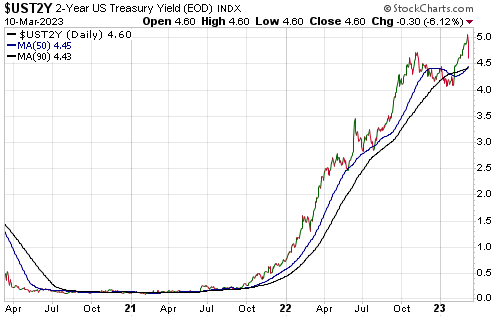[This blog post is an excerpt from a TSI commentary published on 12th March 2023]
The financial markets have been fighting the Fed since October of last year and especially since the start of this year, in two ways. The first involves bidding-up stock prices in anticipation of a ‘Fed pivot’, which we have described as a self-defeating strategy. The second involves factoring lower interest rates into bond prices, which we thought made sense. What is the current state of play in the battle between the markets and the Fed?
Just to recap, we wrote in many previous commentaries that stock market bulls would get the monetary policy reversal on which they were betting only AFTER the SPX plunged to new bear-market lows and the economic data had become weak enough to remove all doubt that a recession was underway. In other words, a very weak stock market was one of the prerequisites for the policy reversal. That, in essence, is why bidding-up prices in anticipation of a policy reversal was/is viewed as a self-defeating strategy. Also worth reiterating is that previous equity bear markets were not close to complete when the Fed made its first rate cut. This implies that if we are still months away from the Fed’s first rate cut then we could be a year away from the final bear market low.
Regarding the other aspect of the Fed fighting, we have written that interest rates probably would move much lower over the course of 2023 due to an economic recession, an extension of the downward trend in inflation expectations and a collapse in the year-over-year CPI growth rate. This meant that from our perspective the financial markets were right to be factoring lower interest rates into Treasury securities with durations of two years or more. However, in the 16th January 2023 Weekly Update we cautioned: “…the recent eagerness of traders to push-up asset prices in anticipation of easier monetary policy has, ironically, extended the likely duration of the Fed’s monetary tightening. Therefore, while the markets probably are right to discount lower interest rates over the coming year, ‘fighting the Fed’ has created a high risk of interest rates rising over the next 1-3 months.”
Partly due to equity traders attempting to ‘front run’ the Fed, the monetary tightening has been extended and interest rates rose markedly from mid-January through to the first half of last week. The 10-year and 30-year Treasury yields have remained below their October-2022 cycle highs, but the 2-year Treasury yield, which had signalled a downward reversal late last year, made new highs over the past fortnight.
The following chart shows the surge in the 2-year Treasury yield from a multi-month low in mid-January to a new cycle high during the first half of last week. It also shows that there was a sharp decline during the second half of last week. Will the latest downward reversal stick?

We suspect that it will. It’s likely that 10-year and 30-year Treasury yields have reversed downward after making lower highs, and that the 2-year Treasury yield has made a sustainable downward reversal from a slightly higher high for the cycle. This is the case because other markets are signalling the start of a shift away from risk.
There’s a good chance that within the next few months stock market bulls will get the Fed pivot they have been betting on. However, they probably will get it with the SPX at 3000 or lower.
 Print This Post
Print This Post
